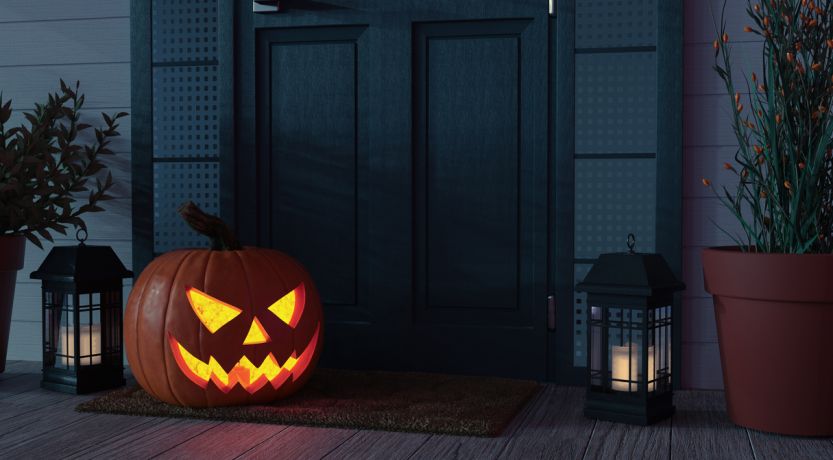The jack-o’-lantern is now associated with the holiday of Halloween. Where did this mysterious symbol come from? What should we do with that knowledge?

Where did the jack-o’-lantern come from?
The childhood of many a person has been haunted by a dark, headless figure on a horse holding a flaming jack-o’-lantern. Washington Irving’s classic horror story “The Legend of Sleepy Hollow” has intrigued and terrified millions for over 200 years.
Interestingly, Washington Irving never mentioned his dark rider bearing a jack-o’-lantern. The author only referred to a shattered pumpkin found the morning after the main character’s disappearance. Adaptations of Irving’s story since then have made the famous pumpkin into the glowing jack-o’-lantern that we all imagine today. Since that fateful connection, the pumpkin with a sinister grin has become an integral part of Halloween.
But where exactly did the jack-o’-lantern come from, and what made it fit in so well with this haunting story and the holiday of Halloween?
Why carve up pumpkins?
The origin of the jack-o’-lantern goes back several centuries, starting with pagan customs that predated even the term jack-o’-lantern. In the dark woods of Ireland, England and Scotland, the Celts ruled. In their religion, the shortening days of autumn indicated the merging of the spirit world with our physical world. This merging was believed to fully happen on their holiday of Samhain (pronounced sah-win) on the night of Oct. 31.
Because of this terrifying belief, the Celts prepared for this time when they believed the spirits of the dead wandered the earth. They imagined that some of the spirits just wandered around, while others were vengeful spirits.
People were mostly defenseless against these dreaded spirits, except for the use of costumes and root vegetables such as turnips with carved faces. To add to the effect, they were “then illuminated by coal, wooden embers, or candles as a way to ward off evil spirits” (Merriam-Webster.com, “The History of ‘Jack-O’-Lantern’”). Displaying these ghastly vegetables was said to keep the spirits from visiting a person’s property.
English historian Ronald Hutton states that root vegetables were “hollowed out to act as lanterns and often carved with grotesque faces,” in association with Samhain, later known as Halloween, in the Celtic part of the world (The Stations of the Sun, 1996).
Eventually, the Roman Empire took over and “christianized” this pagan festival of Samhain, creating All Saints’ Day Nov. 1, with All Hallows Eve (Halloween) the night before. As Irish celebrants eventually moved to the United States, some of the ancient practices came with them. In the United States, the pumpkin was abundant and quickly became the vegetable of choice for carving.
But why call it a “jack-o’-lantern”?
There are various ideas about where the name “jack-o’-lantern” comes from. Britannica in its article “Why Do We Carve Pumpkins at Halloween?” states that it started with the Irish tale of Stingy Jack, who tricked the devil. When he died, the story goes, the deceitful Jack was not allowed to go to heaven due to the life that he had lived. The devil, however, wouldn’t allow him to enter his domain either.
Jack-o’-lanterns may appear fun now, but they have a very dark past that involved pagan worship and an attempt to keep roaming spirits away. To God, anything associated with any of those pagan customs cannot be tolerated in any way, shape or form.
Destined to restlessly roam the earth forever, the spirit of Jack was given a burning ember by Satan. Placing that ember in a carved-out turnip, Jack wandered the countryside with his ghastly lantern. The superstitious Celts believed that mysterious swamp fires, called ignis fatuus, that actually occurred when decaying matter combusted, were evidence Jack’s spirit was roaming nearby. Over time, “Jack of the Lantern” became shortened to “jack-o’-lantern.”
Carved turnips and other vegetables were placed in the window at night to ward off Jack and other unwanted spirits. Naturally, the ghostly tale of Jack of the Lantern came to be associated with Halloween and added to the allure of the dark holiday.
According to History.com, when the Scots and Irish migrated to the United States, they used the abundant pumpkins to ward off evil spirits and celebrate Halloween (“How Jack O’Lanterns Originated in Irish Myth”).
Another, less dramatic, theory for the origin of the name is that a night watchman was generically known as “Jack” (similar to our phrase “John Doe”) and was called a “jack-o’-lantern.” How a night watchman would become associated with the Halloween holiday isn’t clearly explained, so the legend of Stingy Jack seems to be the more likely origin of the term.
What does God think of jack-o’-lanterns?
Many today think that jack-o’-lanterns are cute or fun symbols of a holiday celebrated by many Christians, Halloween. (For more about the origin of Halloween, read “Halloween: Should Christians Celebrate It?”) The symbolism in the minds of some has even changed from one of horror and wandering spirits to one of community, according to National Geographic.
Admittedly, very few will set out jack-o’-lanterns this year hoping to scare off evil spirits. Probably no one will do it in honor of Stingy Jack. Does that mean the symbol has been cleaned up and is okay to use?
Some pagan religions, including Wicca, do still use jack-o’-lanterns for their originally intended purpose.
However, the ultimate question is, What does God think of people using jack-o’-lanterns?
God warns us to avoid spirits or anything associated with them (Leviticus 19:31). He abhors witchcraft and pagan religions, as well as any of the dark arts that delve into an evil spirit world.
God also has strong words to say about mixing His true religion with false and pagan practices: “Take heed to yourself that you are not ensnared to follow them, after they are destroyed from before you, and that you do not inquire after their gods, saying, ‘How did these nations serve their gods? I also will do likewise.’ You shall not worship the LORD your God in that way; for every abomination to the LORD which He hates they have done to their gods; for they burn even their sons and daughters in the fire to their gods” (Deuteronomy 12:30-31).
Jack-o’-lanterns may appear fun now, but they have a very dark past that involved pagan worship and an attempt to keep roaming spirits away. To God, anything associated with any of those pagan customs cannot be tolerated in any way, shape or form.
God knows the origin of the jack-o’-lantern and will not have anything to do with it. What will you do now that you know the origin of the jack-o’-lantern?





